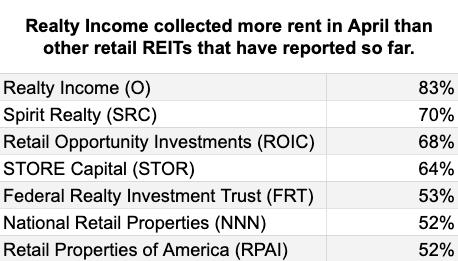Es de Simple Safe Dividends, en versión de prueba 14 días. No sé si un enlace dejaría abrirlo, no creo. Dejo un trocito:
Realty Income’s April Rent Collection Beats Peers But Is Still Problematic
May 6, 2020
On Monday, Realty Income (O) released earnings and reported that 83% of rent was collected in April. Given the circumstances, April rent collection was better than expected and beat that of all other retail REITs we’ve studied.

Source: Company Press Releases
The top four industries in Realty Income’s portfolio have fared well during coronavirus-related shutdowns so far. Convenience stores (11.9% of rent), drug stores (9.0%), dollar stores (8.0%), and grocery stores (7.7%) all remain open and provide essential goods at low price points to consumers.

Source: Realty Income Investor Presentation
Tenant credit quality may also be playing a role. 48% of Realty Income’s rent is from tenants with investment grade credit ratings, and nearly 100% of rent from these tenants was collected in April. Investment grade tenants are, in theory, better positioned to meet their obligations during downturns.
Furthermore, Realty Income’s tenant base is comprised almost entirely of large national and regional operators, which have greater access to financial resources than mom and pop shops and are more likely to survive this rough stretch.
April’s figures are still sobering, though. Realty Income has material exposure to several industries impacted heavily by the pandemic and social distancing, namely restaurants (9.2%), gyms (7.2% of rent), and theaters (6.3%).
Management is in discussions with tenants in these industries to potentially defer several months of rent payments. However, many of these businesses operate on thin margins and may never have capacity to pay back rent in full.
Moreover, some tenants may eventually be forced to close stores or altogether go out of business if conditions don’t improve soon and government stimulus isn’t enough. Vacancies will be difficult to fill in the current retail environment.
This is uncharted territory for Realty Income, who saw same-store rent actually increase 0.4% in 2009 in the midst of the financial crisis.
Based on Realty Income’s pre-pandemic rental income and operating expenses (most of which are fixed costs), we estimate rent revenue could decline around 15% before cash flow (i.e. AFFO) would fall short of covering the dividend.
If rent collection doesn’t improve in the months ahead, Realty Income’s payout ratio will exceed 100%, and management will begin to question the dividend.
Due to the dividend’s lower margin of safety following the firm’s earnings report, we are downgrading Realty Income’s Dividend Safety Score to Safe .
A further downgrade will be considered if conditions worsen or if it becomes clear that rent revenue won’t return to pre-pandemic levels anytime soon.
Essentially, management is able to take a wait-and-see approach given that cash flow is not projected to fall too short of covering the dividend.
Equally as important, Realty Income’s financial position coming into this crisis is strong, affording management the flexibility to tap cash reserves or issue a modest amount of debt to cover a temporary shortfall in dividend’s funding.
Realty Income has ample liquidity with $1.25 billion in cash on hand and access to another $1.1 billion through a revolving credit facility. For context, the dividend costs roughly $880 million annually.
Healthy leverage ratios and an A- credit rating from Standard & Poor’s help ensure access to debt markets if needed, too.




